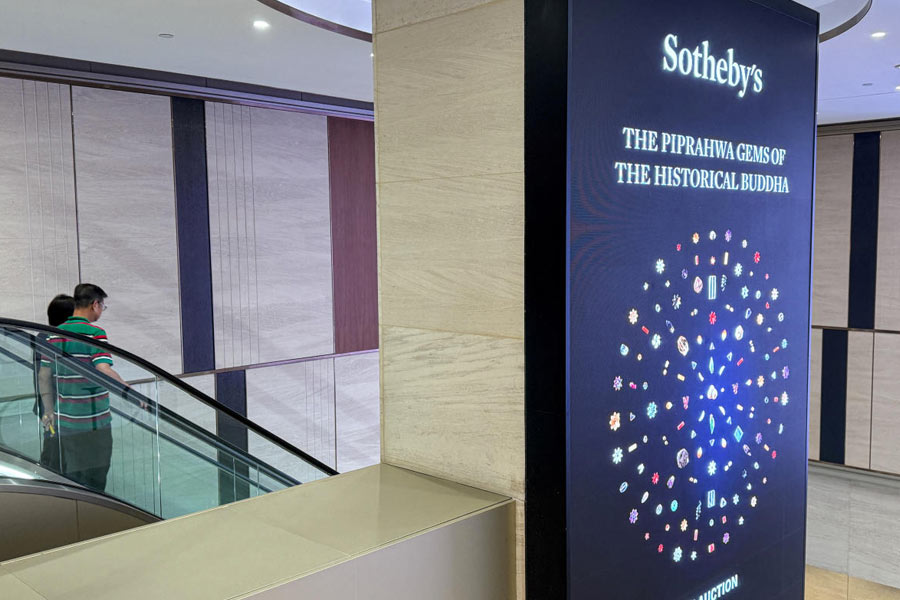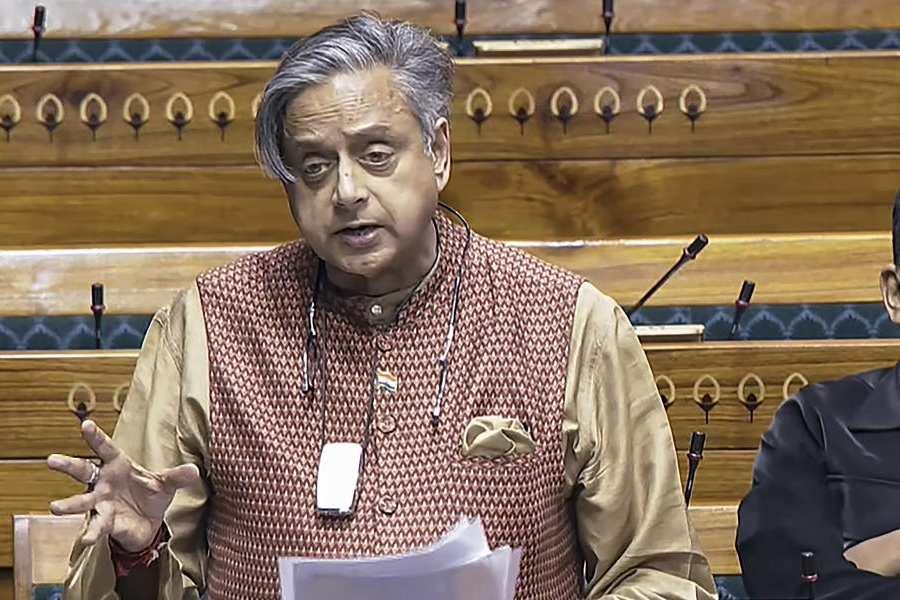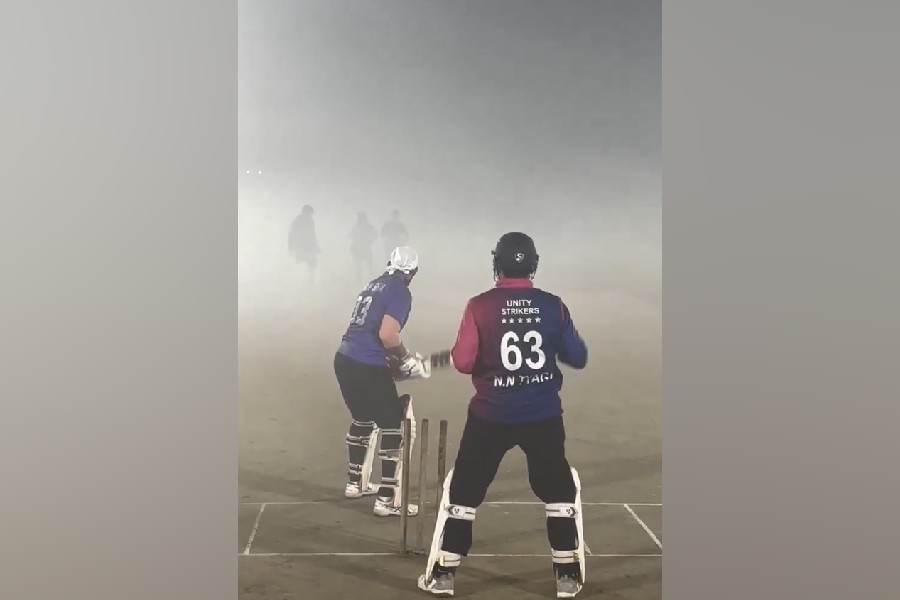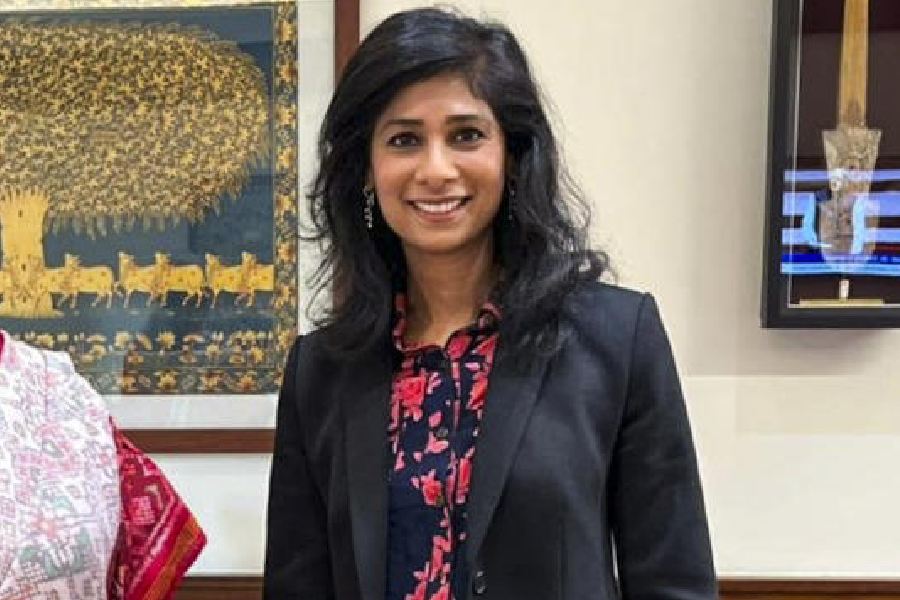They are possibly the most sacred of all the Buddhist relics in the world. Five ancient urns, packed with ashes, gold, and sparkling gems, were found more than a century ago in a stupa in Piprahwa. One urn bore writing declaring the contents to be the ashes “of the Buddha, the August One” that had been gifted to his father’s family, the Sakyas.
Now, a dramatic controversy has erupted: Should Los Angeles-based film director Chris Peppe and two of his cousins be allowed to sell some 350 rubies, emeralds, and other gemstones that were interred with the Buddha’s bones and ashes for thousands of years?
The Indian government says absolutely not – and has forced Sotheby’s, the London auction house, to halt the scheduled sale.
“The Piprahwa stupa has the maximum claim to being an original site – containing the original ashes of the Tathagata, the Bhagwan Buddha himself,” says art historian Naman Ahuja.
Sotheby’s had listed the gems, which were worked into pendants, beads, and other ornaments, as being of “unparalleled religious, archaeological and historical importance,” and set the reserve price at £12 million. The sale has been frozen for now – but the dispute is far from over.
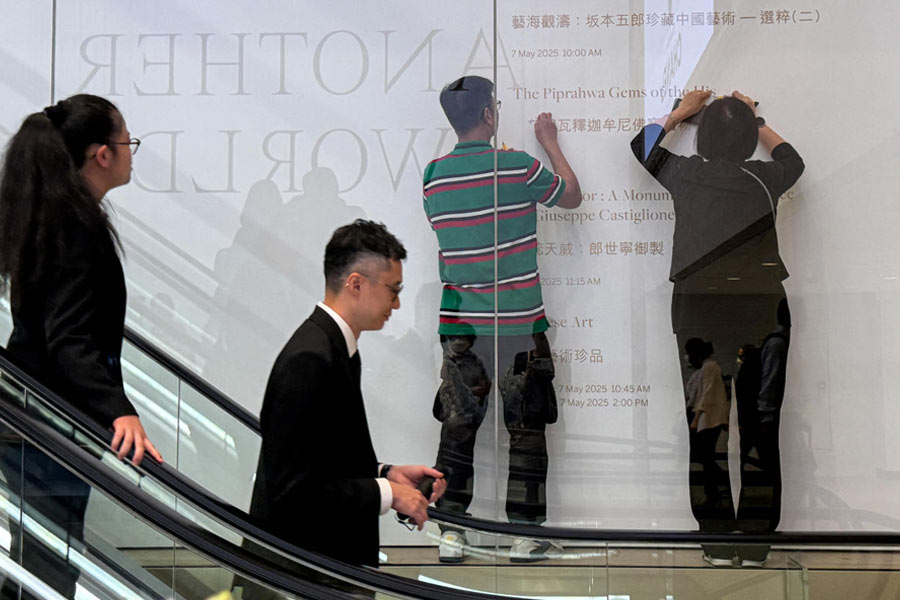
Workers remove a 'The Piprahwa Gems' sign from the wall after auction house Sotheby's postpones an auction of gems tied to Buddha's corporeal relics, following opposition from India, which claims the jewels as its and the global Buddhist community's religious and cultural heritage, in Hong Kong, China, May 7, 2025. (REUTERS)
India, home to the Buddha’s enlightenment, sees the relics not as heirlooms, but as part of a spiritual tradition that binds together half a billion Buddhists across Asia and beyond.
“The nature of the inscription in the Brahmi script, the nature of the sacred archaeology, the location, the quantity of ashes that were buried below these jewels was so large that it’s absolutely clear that this is one of the most important of the ancient stupas,” says Ahuja, an art historian and professor at Jawaharlal Nehru University.
The story of how the Peppe family ended up owning these gems stretches back to 1898. William Peppe, a British estate manager, had his workers cut open what he called a “prominent” mound on land that he oversaw near the Nepal border.
Inside, after digging through 18 feet of solid brickwork, the workers unearthed a huge stone slab. It was the cover of an enormous stone coffer. Underneath were five urns packed with human ashes, gold, and gems. The ancient Brahmi script proclaimed they were the ashes of the Buddha. The fact that they were a part of his ashes given to the Buddha’s father’s family gave them even greater significance.
The extraordinary discovery of the Piprahwa relics marked the beginning of a much larger cultural and archaeological journey.
The ashes from the five urns were handed over to the colonial government, which divided the remains – sending some to the Indian Museum in Calcutta and some to the Mahabodhi Society in the UK. The King of Siam, Rama V, petitioned for a portion of the remains, and they were sent to him with due ceremony. The gold and jewellery interred with the remains went to the Indian Museum. But about a fifth of the 1,800 gems were left in the hands of the Peppe family. The National Museum in Delhi also has a set of relics and has even fixed times when Buddhists can worship there.
William Peppe, who appears to have been a trained engineer, understood that he had uncovered something important. But he probably never realised the scale of the archaeological ruins that existed beneath the stupa.
Over the decades, archaeologists dug deeper into the stupa – and found even more chambers that may have housed additional urns. One theory holds that the urns with the Buddha’s ashes were originally placed in the lower chambers and moved up two centuries later.
And that’s not all. Some historians now believe – though there are strong disputes over this – that Piprahwa was actually once the site of Kapilavastu, the ancient capital of the Sakya dynasty and the Buddha’s childhood home. That would place one of Buddhism’s holiest cities firmly in Indian territory.
Nepalese archaeologists and historians, in particular, fiercely reject this conclusion. They insist that Kapilavastu is located at a place just across the border called Tilaurakot in Nepal. Piprahwa is around 10km from Lumbini in Nepal, where the Buddha was born.
It’s become a dispute with national pride on the line.
Indian historians beg to differ – strongly. They point out that there’s no stupa at Tilaurakot. Also, the Archaeological Survey of India’s K.M. Shrivastava ordered extensive excavations in Piprahwa and uncovered other structures around the stupa.
Shrivastava wrote about his finds: “The proximity of these structures to the ancient site of Piprahwa, where the sealings with the name of Kapilavastu were found, their impressive size and constructional features and the large quantity of antiquities found within them, leave little doubt that the structures formed the residential complex of the chief of the capital town, Kapilavastu. I.e., the Sakya king Suddhodhana and his predecessors.”
While the relics found at Piprahwa are among the most significant, they are part of a much wider tradition. After the Buddha’s death in around 480 BC, his ashes were originally divided among eight kingdoms, each enshrining them in stupas. Later, Emperor Ashoka is said to have redistributed these relics across his empire, placing them in thousands of stupas to spread the Buddha’s message.
The gems are considered sacred because they lay alongside the Buddha’s ashes for centuries, absorbing the reverence and sanctity accorded to his mortal remains.
The attempt to auction the gems that had been interred with the Buddha’s remains has created a particularly tricky situation for India. As the birthplace of the Buddha, it has taken public custody of the relics seriously and assumed a leadership role in Buddhist affairs. There’s even a joint secretary looking after Buddhist affairs in the Union culture ministry.
“The whole Buddhist world is therefore looking to India and asking what we are doing about it. India cannot be seen to be negligent in its role as the land of the Buddha,” says Ahuja.
India has taken its role as guardian of the affairs of the Buddha seriously in the past. In 1952, not long after Independence, Britain returned Buddhist relics that had once been in Sanchi and other places in Madhya Pradesh. Prime Minister Jawaharlal Nehru received these relics with full ceremonial honours.
“India adopted and nurtured a certain foreign policy status as being the holy land of Buddhism,” says Ahuja, who is known for his expertise in ancient Indian art, archaeology, and iconography.
“Millions of pilgrims come to India every year for blessings, and India has taken on a very serious role across Southeast Asia and the Buddhist world in what we call ‘relic diplomacy’,” notes Ahuja.
Today, Buddhist relics are sometimes flown to places like Thailand or other Buddhist nations. They are sent with great ceremony aboard Indian Air Force planes “as if we are sending the head of our state,” notes Ahuja.
Critics argue that the attempt to auction the relics reflects a colonial-era mindset that is treating sacred relics as private property, rather than acknowledging they belong to India.
There is, of course, a global trade in plundered Buddhist relics. That began during the colonial era and has continued to flourish in more recent decades.
The plundering went into a new scale in the colonial and post-colonial era, especially in places like Afghanistan and what was called the Gandhara region in northwest Pakistan, says Ahuja.
So what now? How can India recover the gems — which Buddhists believe are imbued with the presence of the Buddha — that are now held by the Peppe family? Chris Peppe, who is a great-grandson of William Peppe, insists that none of the Buddhist temples or experts he has spoken to regard the gems as corporeal remains.
Ahuja is unequivocal: paying for such sacred objects is unthinkable. Nor is letting them slip away into the private vaults of the wealthy.
The sale would set a precedent. “By putting them on the market, India has been pushed into a corner to officially condone the sale of Buddha’s relics to the highest bidder,” says Ahuja.

